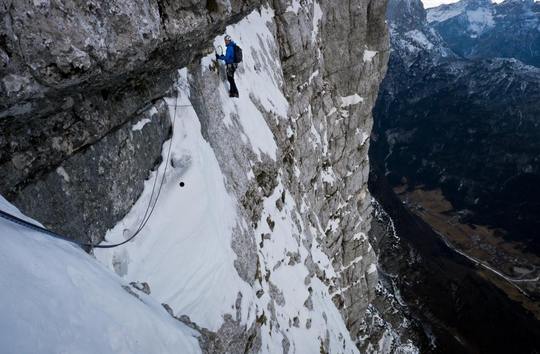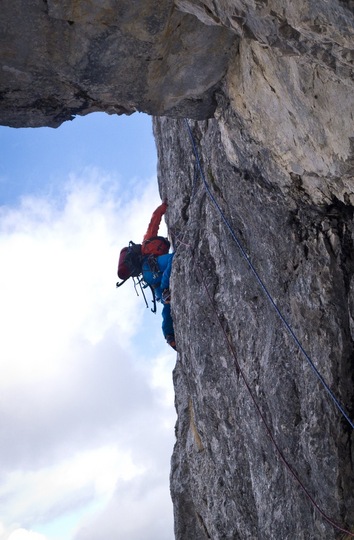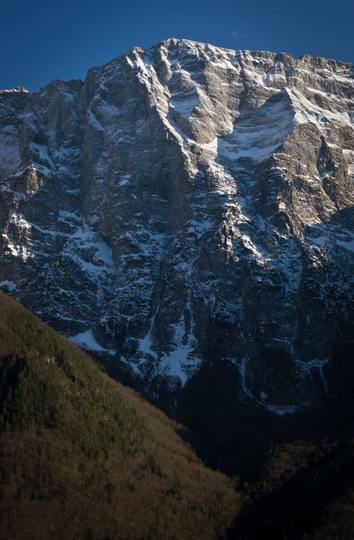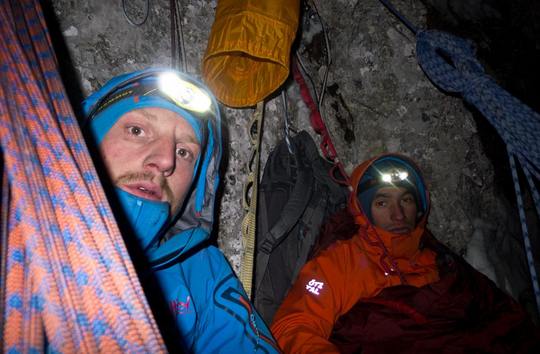
Peter Ortner leading a traversing pitch on his and David Lama’s new route on Loska Stena’s north face. The pair climbed the Lama-Ortner (7 M6, 1300m) over the course of three days in alpine style and recommend that anyone attempting the route in the future bring “a large range of pitons.” [Photo] David Lama
On February 25, David Lama and Peter Ortner established a new route on the north face of Loska Stena, a circa 1000m high, five kilometer wide rock wall in Slovenia’s Julian Alps. Lama and Ortner, fresh from their first free climb of the Compressor Route, spent three days establishing the new, thirteen-pitch route, the Lama-Ortner (7 M6, 1300m).

Lama leading on the first ascent of the Lama-Ortner. [Photo] Peter Ortner
Loska Stena is located in Triglav National Park, in the north west of the country. The park encompasses 880 square kilometers and is named for the tallest peak in the Julian Alps, Triglav (2864m), whose image is on the nation’s seal and flag. The park was founded in 1924, making it one of the earliest European parks. Just before the pair left for Patagonia this season Ortner showed Lama a photo of Loska Stena, and the pair decided to try to put up a new route on it as soon as they returned from South America. “It just looked like a great adventure,” writes Lama.
Lama and Ortner hiked to the base of Loska Stena in spring-like conditions. They climbed the first 400 meters of the route ropeless because “the difficulties were still manageable,” Lama explains. After that the climbing became more challenging, and the pair climbed six roped pitches before settling onto a small ledge for their first bivy.

The north face of Slovenia’s Loska Stena wall, where Lama and Ortner climber their new route. [Photo] Peter Ortner
Nighttime temperatures plummeted; while leading the next morning’s first rope length Lama “couldn’t feel [his] fingers.” Protection opportunities gradually became rarer and rarer. “Looking down, I could barely see my last piece of gear,” reports Lama. Ortner took the lead for the next pitch, encountering the same freezing temperatures and runout climbing. The pair continued for another six pitches until the climbing above looked altogether impossible. After a long traverse to more accessible terrain, Lama and Ortner settled onto a ledge and spent their second night on the wall.
February 27 began just as cold as the previous day. Lama and Ortner began climbing just before 8 a.m.. The first two pitches from the bivy followed a large corner to the top of a pillar. After the pillar, only four pitches remained between the climbers and the summit snowfield. Shortly after noon, Lama and Ortner were standing on top of Loska Stena.
Lama writes that though the route is rated at 7 M6, “the total demand of the route is a lot higher, due to poor protection.” He advises that future climbers be careful and warns that “after the first 600 meters, retreat is hardly possible.” Lama also notes that this is the first route that he and Ortner did not climb as they had planned. “At some point, Peter and I decided that we had already [taken] enough risks and traversed to the right into easier terrain. I think that it was a good decision.”

Ortner and Lama during a chilly night on the wall. [Photo] Peter Ortner